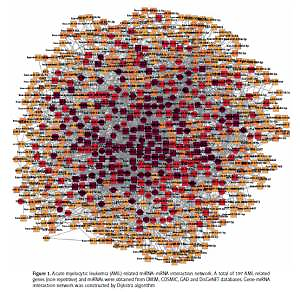Current issue
Archive
Manuscripts accepted
About the Journal
Editorial office
Editorial board
Section Editors
Abstracting and indexing
Subscription
Contact
Ethical standards and procedures
Most read articles
Instructions for authors
Article Processing Charge (APC)
Regulations of paying article processing charge (APC)
HEMATOLOGY / BASIC RESEARCH
MicroRNA-107 promotes apoptosis of acute myelocytic leukemia cells by targeting RAD51
1
Department of Medical Technology Clinical and Hematological Laboratory Office,
Xi’an Medical University, Xi’an, Shaanxi, China
2
Department of Radiology, Affiliated Hospital of North Sichuan Medical College,
Nanchong, Sichuan, China
3
Department of Laboratory Medicine, North Sichuan Medical College, Nanchong,
Sichuan, China
4
Department of Clinical Laboratory, Affiliated Hospital of North Sichuan Medical College,
Nanchong, Sichuan, China
5
Translational Medical Research Center, North Sichuan Medical College, Nanchong,
Sichuan, China
Submission date: 2018-01-18
Final revision date: 2018-05-23
Acceptance date: 2018-06-11
Online publication date: 2020-02-04
Publication date: 2021-07-16
Arch Med Sci 2021;17(4):1044-1055
KEYWORDS
TOPICS
ABSTRACT
Introduction:
This study aimed to investigate the role of microRNA (miRNA) that affects acute myelocytic leukemia (AML) and its potential molecular mechanism by constructing a miRNA–mRNA interaction network using bioinformatics methods.
Material and methods:
MicroRNA expression data of AML were retrieved from Gene Expression Omnibus (GEO) and analyzed by microarray analysis. Expression levels of miR-107 and RAD51 mRNA were detected by quantitative real time polymerase chain reaction (qRT-PCR). Protein expression of RAD51, pro-apoptotic protein Bax, apoptosis related protein CytC and anti-apoptotic protein Bcl-2 were determined by Western blot. The rate of cell apoptosis was detected by Annexin-V/PI. The predicted targeting relationship between miR-107 and the 3′UTR of RAD51 was first predicted by the online application TargetScan and then verified by dual-luciferase assay.
Results:
Acute myelocytic leukemia-associated genes (n = 197) and miRNAs (n = 1701) were retrieved from the database, the interaction network of miRNA-mRNA was constructed and the core position was occupied by RAD51. miR-107 exhibited a regulatory effect on RAD51 in which the mRNA and protein expression of RAD51 were both significantly inhibited by miR-107 mimics in vitro. Additionally, down-regulated expression of miR107 as well as up-regulated expression of RAD51 were detected not only in the plasma of AML patients compared to healthy volunteers, but also in AML cell lines compared to the normal bone marrow stromal cell line. Further study found that increased expression of miR-107 and the consequent down-regulation of RAD51 could aggravate the apoptosis of AML cells in vitro.
Conclusions:
Our present results showed that the crucial role of RAD51 and miR-107 in the apoptosis of AML cells, i.e., miR-107 promotes the apoptosis of AML cells through down-regulating the expression of RAD51.
This study aimed to investigate the role of microRNA (miRNA) that affects acute myelocytic leukemia (AML) and its potential molecular mechanism by constructing a miRNA–mRNA interaction network using bioinformatics methods.
Material and methods:
MicroRNA expression data of AML were retrieved from Gene Expression Omnibus (GEO) and analyzed by microarray analysis. Expression levels of miR-107 and RAD51 mRNA were detected by quantitative real time polymerase chain reaction (qRT-PCR). Protein expression of RAD51, pro-apoptotic protein Bax, apoptosis related protein CytC and anti-apoptotic protein Bcl-2 were determined by Western blot. The rate of cell apoptosis was detected by Annexin-V/PI. The predicted targeting relationship between miR-107 and the 3′UTR of RAD51 was first predicted by the online application TargetScan and then verified by dual-luciferase assay.
Results:
Acute myelocytic leukemia-associated genes (n = 197) and miRNAs (n = 1701) were retrieved from the database, the interaction network of miRNA-mRNA was constructed and the core position was occupied by RAD51. miR-107 exhibited a regulatory effect on RAD51 in which the mRNA and protein expression of RAD51 were both significantly inhibited by miR-107 mimics in vitro. Additionally, down-regulated expression of miR107 as well as up-regulated expression of RAD51 were detected not only in the plasma of AML patients compared to healthy volunteers, but also in AML cell lines compared to the normal bone marrow stromal cell line. Further study found that increased expression of miR-107 and the consequent down-regulation of RAD51 could aggravate the apoptosis of AML cells in vitro.
Conclusions:
Our present results showed that the crucial role of RAD51 and miR-107 in the apoptosis of AML cells, i.e., miR-107 promotes the apoptosis of AML cells through down-regulating the expression of RAD51.
Share
RELATED ARTICLE
We process personal data collected when visiting the website. The function of obtaining information about users and their behavior is carried out by voluntarily entered information in forms and saving cookies in end devices. Data, including cookies, are used to provide services, improve the user experience and to analyze the traffic in accordance with the Privacy policy. Data are also collected and processed by Google Analytics tool (more).
You can change cookies settings in your browser. Restricted use of cookies in the browser configuration may affect some functionalities of the website.
You can change cookies settings in your browser. Restricted use of cookies in the browser configuration may affect some functionalities of the website.



